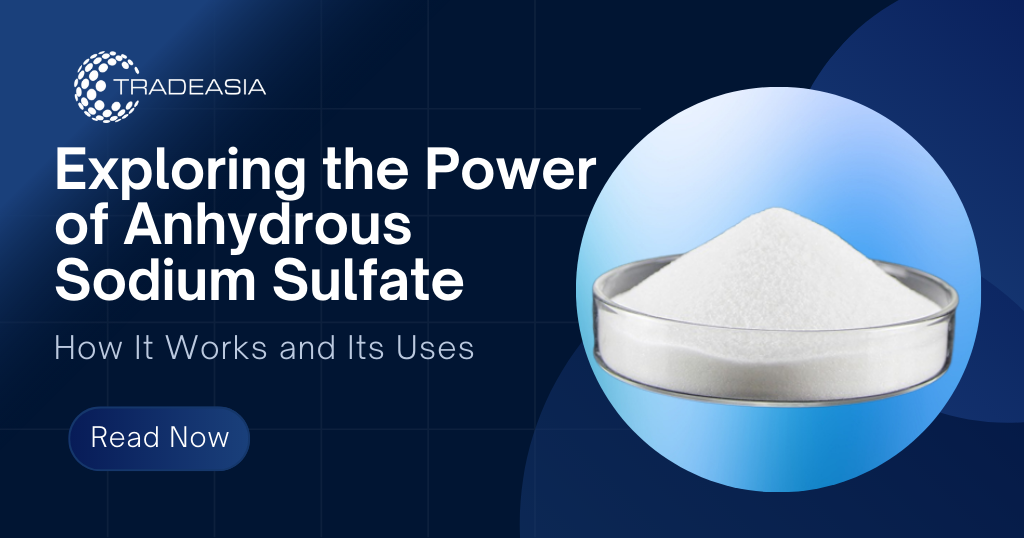
Introduction
Have you ever wondered about the science behind anhydrous sodium sulfate? Despite its simple name, this compound possesses incredible abilities that extend far beyond its appearance. In this article, we’ll take a closer look at anhydrous sodium sulfate, exploring its functions, its mechanism of action, and the diverse range of applications it serves across various industries. Whether you’re a curious student or someone intrigued by the world of chemistry, prepare to be captivated by the power of anhydrous sodium sulfate.
What is Anhydrous Sodium Sulfate?
Anhydrous sodium sulfate might sound like a mouthful, but it’s essentially a type of salt – the kind that doesn’t have water molecules clinging to it. “Anhydrous” means “without water,” and this compound is known for its impressive ability to soak up moisture. Anhydrous sodium sulfate, commonly referred to as “anhydrous salt,” is a dry, crystalline compound with the chemical formula Na2SO4. Unlike its hydrated counterpart, anhydrous sodium sulfate does not contain water molecules within its structure. This absence of water molecules gives it remarkable water-absorbing properties, making it a valuable tool in moisture removal processes.
How Does Anhydrous Sodium Sulfate Remove Water?
Anhydrous sodium sulfate’s water-removing prowess lies in its hygroscopic nature. Hygroscopic materials have a natural affinity for water molecules in their surroundings. When anhydrous sodium sulfate comes into contact with a moist environment, it eagerly absorbs the water molecules through a process called adsorption. This absorption leads to the formation of hydrated sodium sulfate crystals while leaving the environment noticeably drier. Imagine anhydrous sodium sulfate as a thirsty sponge. When it comes into contact with a substance containing water, like a wet solution or a damp surface, it eagerly absorbs the water molecules. This process is called desiccation, and it’s like magic – the anhydrous sodium sulfate literally sucks the water out, leaving things dry and moisture-free.
How Does Anhydrous Sodium Sulfate Work?
Anhydrous sodium sulfate works through a simple yet effective mechanism. When it encounters water vapor, it undergoes a physical transformation as it adsorbs the water molecules. This transformation is exothermic, meaning it releases heat. As a result, the absorbed water vapor causes the anhydrous sodium sulfate crystals to clump together, indicating that the compound has successfully fulfilled its water-absorbing duty.
At a molecular level, anhydrous sodium sulfate is structured in a way that allows it to trap and hold onto water molecules. This is due to its crystalline structure, which provides ample surface area for water to attach. So, when you mix anhydrous sodium sulfate with something wet, it’s like giving it a feast to devour.
What Does Anhydrous Sodium Sulfate Do?
The primary function of anhydrous sodium sulfate is to act as a desiccant, which is a substance used to remove moisture from its surroundings. This quality finds applications in various industries, including pharmaceuticals, food production, and manufacturing. It prevents the degradation of sensitive products by maintaining a dry environment and extends their shelf life.
Anhydrous sodium sulfate might be to get rid of unwanted water, but its importance goes beyond that. It’s a common ingredient in various industries. For instance, in laboratories, it’s used to dry solvents, ensuring chemical reactions proceed smoothly. In the beauty and pharmaceutical world, it helps create powders and prevent moisture-related clumping.
Applications of Anhydrous Sodium Sulfate
Anhydrous sodium sulfate’s versatility doesn’t stop there. It plays a pivotal role in the production of detergents, helping them remain free-flowing. Additionally, it’s a key player in the paper and textile industries, where it assists in dyeing processes and prevents fiber clumping. Even in the food industry, it finds its place by keeping powdered spices from turning into sticky messes.
Common Uses of Anhydrous Sodium Sulfate
Pharmaceutical Industry: Anhydrous sodium sulfate is used to ensure the dryness of reagents, chemicals, and pharmaceutical compounds during production and storage. Its moisture-absorbing properties prevent the growth of mold and bacteria, preserving the integrity of medications and laboratory materials.
Food Industry: In the food industry, anhydrous sodium sulfate finds its place as a drying agent. It helps maintain the texture and quality of various powdered and dry food products, such as spices, instant soups, and powdered drink mixes.
Manufacturing Processes: Anhydrous sodium sulfate is a crucial component in manufacturing processes that require moisture control. It prevents unwanted reactions between water and raw materials, ensuring the quality of products like detergents, paper, and textiles.
Oil and Gas Industry: This compound plays a role in natural gas production, aiding in the removal of water vapor from natural gas streams. Its ability to absorb water vapor helps prevent corrosion and blockages in pipelines.
Conclusion
Anhydrous sodium sulfate’s remarkable ability to remove water makes it an essential compound in various industries. Whether it’s safeguarding pharmaceuticals, preserving food quality, or optimizing manufacturing processes, anhydrous sodium sulfate proves its worth as a reliable desiccant. Its simple yet effective mechanism has earned it a place as a moisture-controlling superstar in today’s industrial landscape. So, there you have it – a glimpse into the remarkable world of anhydrous sodium sulfate. From its ability to bid farewell to water to its multiple roles across industries, this unassuming compound proves that even the smallest things can make a big difference. Next time you enjoy a powdered drink or use a detergent, you’ll know that anhydrous sodium sulfate is working its magic behind the scenes.




